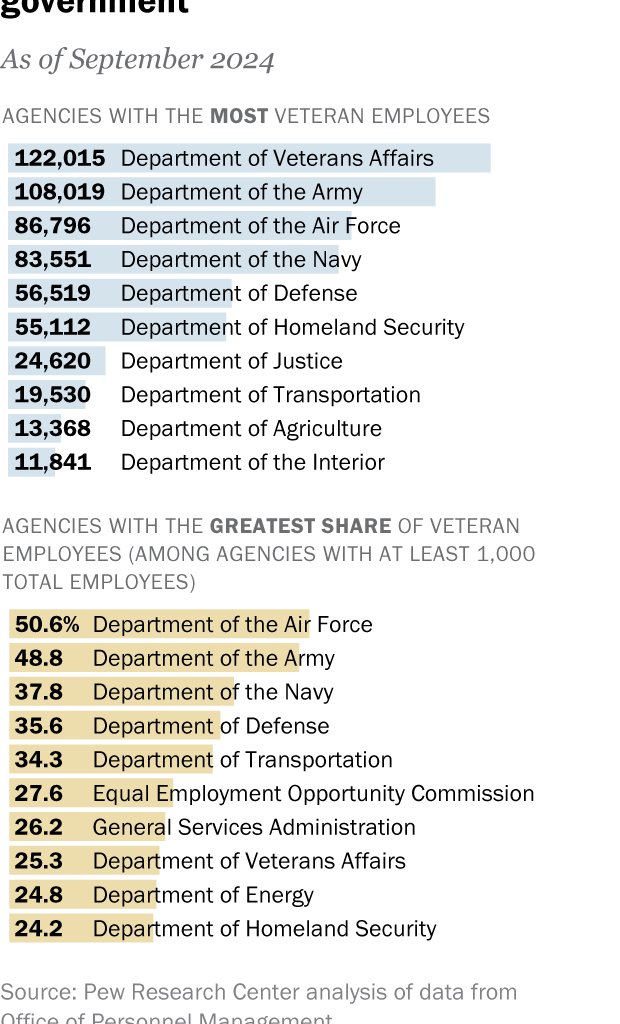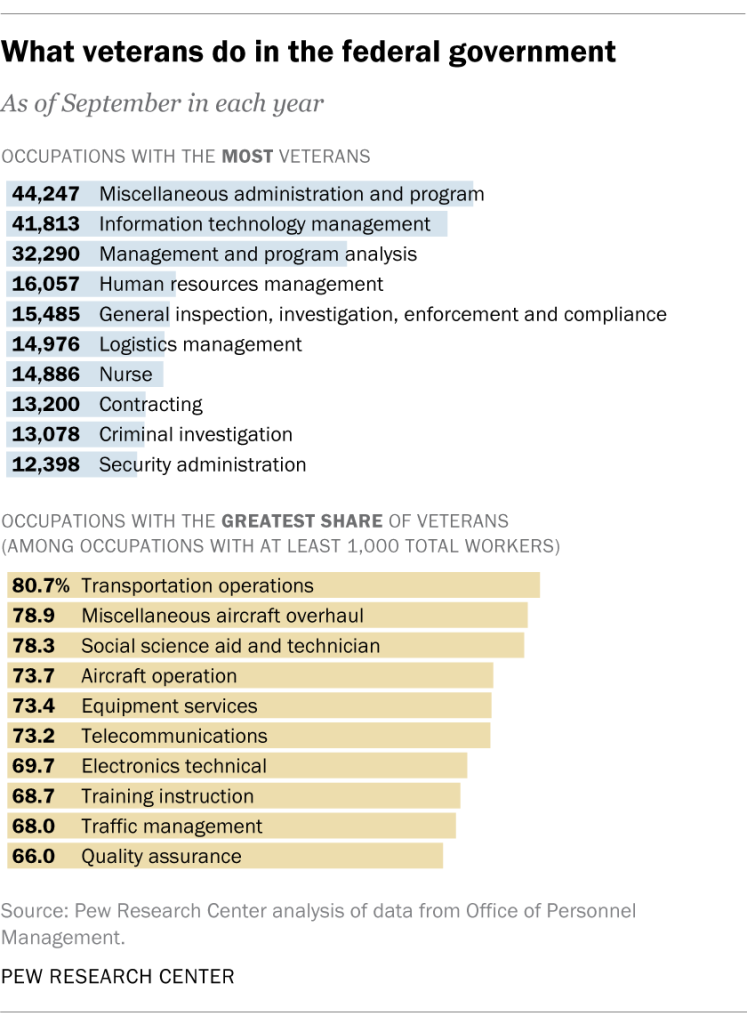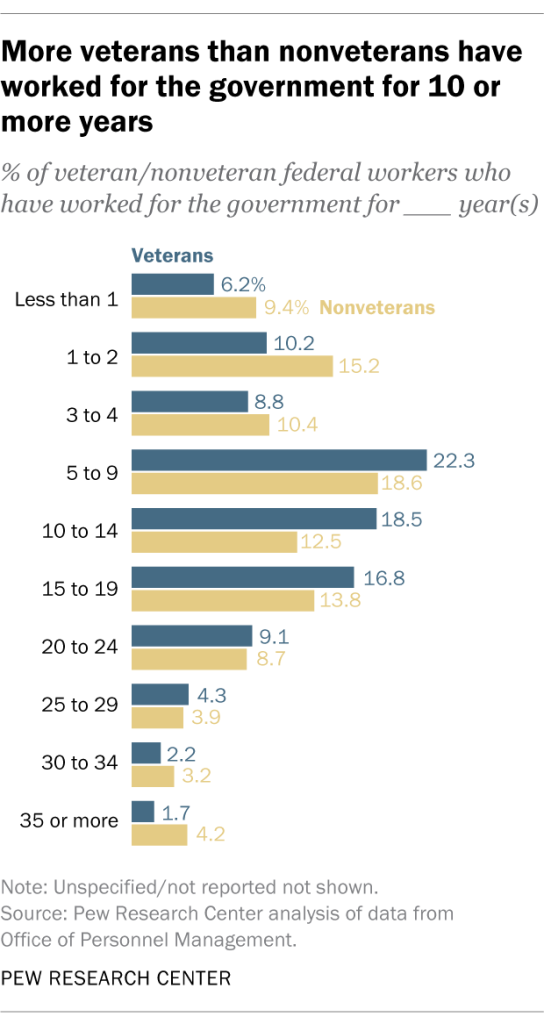Table of Contents
As of September 2024, veterans make up a significant portion of the federal government workforce, with more than 700,000 veterans working across various U.S. federal departments and agencies. This figure represents nearly a quarter (24%) of the entire civilian workforce of the U.S. government, a stark contrast to the approximately 5% of all employed Americans who are veterans. With this high concentration of veterans in federal positions, understanding the roles and contributions of these workers is key to recognizing the impact of veterans in public service.

This blog post dives into the demographics, job roles, and educational backgrounds of veterans in the federal workforce, using data from the Office of Personnel Management’s FedScope database, which tracks nearly all executive-branch civilian employees. This analysis helps illuminate the importance of veterans in the government and the challenges and opportunities they face.
How Many Federal Workers Are Veterans?
At the close of fiscal 2024, around 713,000 veterans were employed across the federal government. This figure includes over 642,000 veterans at executive-branch agencies and more than 70,000 at the Postal Service. In total, the federal government employed approximately 3.01 million civilian workers, meaning veterans represented 24% of this workforce. This figure excludes active-duty military personnel, who aren’t typically considered part of the civilian workforce but still play a crucial role in national defense.

How Has the Share of Veterans in Federal Jobs Changed Over Time?
Over the past two decades, the proportion of veterans working in the federal government has fluctuated, with peaks and valleys. The highest share was 31.6% in 2016 and 2017, while the current share stands at 27.8% in 2024, marking a slight decline. The Postal Service has remained relatively stable, with veterans making up about 10-11% of the workforce in recent years. Despite these fluctuations, veterans remain a steadfast presence in the federal government.

Which Federal Agencies Employ the Most Veterans?
Among the largest federal agencies, those with at least 1,000 employees, veterans are particularly prevalent in departments with military connections. The Department of Defense and its associated military branches, such as the Department of the Air Force and the Department of the Army, employ large numbers of veterans. In fact, veterans make up over 50% of the civilian workforce at the Department of the Air Force (86,796 veterans out of 171,657 employees) and nearly half at the Department of the Army (108,019 veterans out of 221,222 employees).
Other agencies with strong military ties, such as the Selective Service System (57% of its 162 employees) and the American Battle Monuments Commission (63% of its 78 employees), also show a high percentage of veterans in their workforce.
However, veterans also contribute significantly to federal agencies outside of the military domain. For example:
- Transportation Department: 34.3% of employees are veterans.
- Equal Employment Opportunity Commission: 27.6% of employees are veterans.
- General Services Administration: 26.2% of employees are veterans.
These figures show that veterans are not only integral to the Department of Defense but also play a crucial role in other areas of federal service.
What Jobs Do Veteran Workers Do for the Federal Government?
Veterans in the federal workforce hold a wide array of positions, ranging from “able seaman” to “zoologist”. However, veterans tend to predominate in specific occupational categories. Among jobs with more than 1,000 total workers, the following categories have the highest shares of veterans:
- Armaments workers: 64.3% are veterans.
- Equipment, facilities, and services workers: 58.6% are veterans.
- General equipment maintenance workers: 57.1% are veterans.
- Supply and inventory workers: 53.7% are veterans.
- Aircraft service and repair workers: 53.2% are veterans.
Specific occupations that employ large numbers of veterans include:
- Miscellaneous administration and program work: 39% of the 113,373 workers are veterans.
- Information technology management: 41% of the 101,000 workers are veterans.
- Management and program analysis: 33% of the 96,800 workers are veterans.
These job categories highlight the significant contributions veterans make in technical roles as well as management and administration across the federal government.

How Do Veterans and Nonveterans in the Federal Workforce Compare?
Veterans and nonveterans in the federal workforce have distinct demographic profiles. Some notable differences include:
- Age: Veterans are generally older than their nonveteran counterparts. While 18.5% of veterans are under the age of 40, nearly 35% of nonveterans fall into this age range. A larger share of veterans (51.8%) are aged 50 and older, compared to 37.6% of nonveterans.
- Gender: Veterans in the federal workforce are overwhelmingly male—78.5% of veterans compared to 44% of nonveterans.
- Education: Veterans are less likely than nonveterans to have a college degree. About 32.1% of veterans have a high school education or less, compared to 27% of nonveterans. Conversely, 56.4% of nonveterans hold a bachelor’s degree or higher, compared to 47.1% of veterans.
- Length of Service: Veterans typically have longer tenure in federal employment, with an average of 12 years compared to 11.7 years for nonveterans. However, a higher percentage of nonveterans (11.4%) have been with the federal government for 25 years or more, compared to just 8.2% of veterans.

Conclusion: Veterans as an Integral Part of the Federal Workforce
Veterans represent a significant portion of the federal government workforce, contributing their expertise and experience to a wide range of occupations. From military-related departments like the Department of Defense to civilian agencies such as the Transportation Department and General Services Administration, veterans continue to play an integral role in shaping the operations of the U.S. government.
Despite some challenges, such as the impact of political decisions like federal payroll cuts, veterans remain an indispensable part of the federal workforce. As the government continues to evolve, recognizing and supporting the contributions of veterans will be key to ensuring a skilled, experienced, and diverse federal workforce for the future.
Author Profile
- Syed Tahir Abbas is a Master's student at Southwest University, Chongqing, specializing in international relations and sustainable development. His research focuses on U.S.-China diplomacy, global geopolitics, and the role of education in shaping international policies. Syed has contributed to academic discussions on political dynamics, economic growth, and sustainable energy, aiming to offer fresh insights into global affairs.
Latest entries
 Japanese PoliticsSeptember 6, 2025Prince Hisahito’s Coming-of-Age and Japan’s Male-Only Succession Dilemma
Japanese PoliticsSeptember 6, 2025Prince Hisahito’s Coming-of-Age and Japan’s Male-Only Succession Dilemma GeopoliticsAugust 23, 2025Previewing the White House Visit of South Korean President Lee Jae Myung
GeopoliticsAugust 23, 2025Previewing the White House Visit of South Korean President Lee Jae Myung Middle East ConflictJuly 22, 2025Israel’s Deadly Attacks on Gaza: A Dire Humanitarian Crisis and International Calls for a Truce
Middle East ConflictJuly 22, 2025Israel’s Deadly Attacks on Gaza: A Dire Humanitarian Crisis and International Calls for a Truce Middle East & North AfricaJuly 20, 2025Israel Targets Damascus Amid Rising Tensions in Syria
Middle East & North AfricaJuly 20, 2025Israel Targets Damascus Amid Rising Tensions in Syria



1 comment
Your passion for the topic really shines through. Keep it up😍😍😍